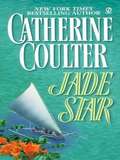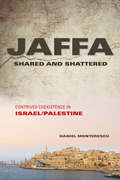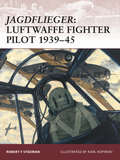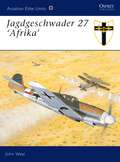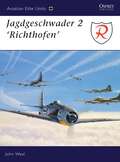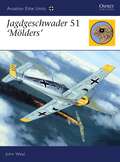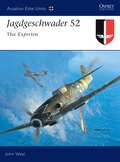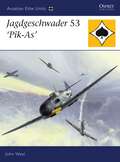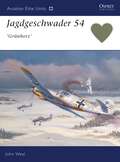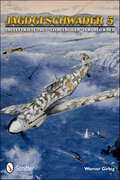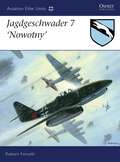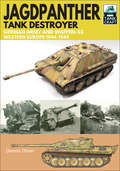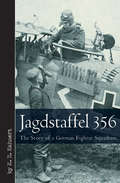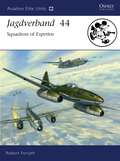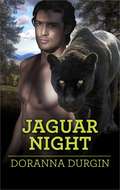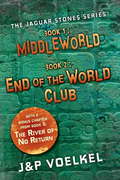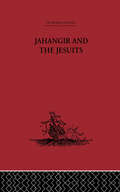- Table View
- List View
Jade Star
by Catherine CoulterVowing to save a young girl from her painful past, Saint Morris marries her out of duty. He thinks of himself as her protector and brother. But she has other ideas....
Jadid al-Islam: The Jewish “New Muslims” of Meshhed (Raphael Patai Series in Jewish Folklore and Anthropology)
by Raphael PataiIn 1839, Muslims attacked the Jews of Meshhed, murdering 36 of them, and forcing the conversion of the rest. While some managed to escape across the Afghan border, and some turned into true believing Muslims, the majority adopted Islam only outwardly, while secretly adhering to their Jewish faith. Jadid al-Islam is the fascinating story of how this community managed to survive, at the risk of their lives, as crypto-Jews in an inimical Shi'i Muslim environment. Based on unpublished original Persian sources and interviews with members of the existing Meshhed community in Jerusalem and New York, this study documents the history, traditions, tales, customs, and institutions of the Jadid al-Islam--"New Muslims."
Jadwiga, Poland’s Great Queen
by Charlotte Kellogg Frank H. SimondsHERE is the story of a great love and a great sacrifice and of a queen’s work built on that sacrifice. It takes us back five hundred years, to the brilliant court of that King Louis of Hungary who ruled the half of Europe—the court where his gifted youngest daughter, Jadwiga, grew up. It takes us to Vienna, for Jadwiga was betrothed to the young Crown Prince of Austria. Then to Krakow, early capital of Poland, where Jadwiga was called as queen and where she made her supreme renunciation.Through it and her marriage with the Lithuanian Grand Duke, Jagiello, she brought the last pagan people of Europe into the fold of the Western Church, and raised a barrier against the eastern push of the German soldiers of the Cross, which made possible a Poland stretching from the Baltic to the Black Sea. Thenceforth the union of Poland and Lithuania was known as the “Wedding ring of Jadwiga.”Through darkest days she kept her faith, until she was reverenced throughout Europe for her holiness and admired for her wisdom. Like Joan of Arc in France, she has been in Poland a symbol of national aspiration and a source of national idealism.This book represents years of travel and research and has already been accepted by the Polish historical congress. It is important as history and interesting also as the love story of a great woman.
Jaffa Shared and Shattered
by Daniel MonterescuBinational cities play a pivotal role in situations of long-term conflict, and few places have been more marked by the tension between intimate proximity and visceral hostility than Jaffa, one of the "mixed towns" of Israel/Palestine. In this nuanced ethnographic and historical study, Daniel Monterescu argues that such places challenge our assumptions about cities and nationalism, calling into question the Israeli state's policy of maintaining homogeneous, segregated, and ethnically stable spaces. Analyzing everyday interactions, life stories, and histories of violence, he reveals the politics of gentrification and the circumstantial coalitions that define the city. Drawing on key theorists in anthropology, sociology, urban studies, and political science, he outlines a new relational theory of sociality and spatiality.
Jagatna Itihas nu Sankshipt Rekha Darshan
by Jawaharlal Nehruછોકરાછોકરીઓ માત્ર એક જ દેશનો ઇતિહાસ શીખે, અને તેમાં પણ ઘણી વાર તો તેઓ કેટલીક તારીખો અને થોડી હકીકતો ગોખી કાઢે, એ મને જરાયે પસંદ નથી. ઇતિહાસ એ તો એક સળંગસૂત્ર અને અખંડ વસ્તુ છે; એટલે દુનિયાના ઇતર ભાગોમાં શું બન્યું હતું એનાથી માહિતગાર ન હોઈએ તો આપણે કોઈ એક દેશનો ઇતિહાસ પણ બરાબર ન સમજી શકીએ. હું ઉમેદ રાખું છું કે આમ સંકુચિત દૃષ્ટિથી કેવળ એકબે દેશ પૂરતો જ નહીં પણ આખી દુનિયાનું અવલોકન કરીને વ્યાપક દૃષ્ટિથી તું ઇતિહાસ શીખશે. તું હંમેશાં એટલું યાદ રાખજે કે, દુનિયાની જુદી જુદી પ્રજાઓમાં આપણે ધારી લઈએ છીએ તેટલી બધી ભિન્નતા કે તફાવત નથી. નકશાઓ કે નકશાપોથીઓ જુદા જુદા દેશોને આપણને ભિન્ન ભિન્ન રંગોમાં દર્શાવે છે. બેશક, પ્રજાઓ એકબીજીથી ભિન્ન છે ખરી, પણ તેમનામાં પરસ્પર સામ્ય પણ ઘણું જ છે. આ વસ્તુ આપણે બરાબર લક્ષમાં રાખવી જોઈએ અને નકશાઓના રંગોથી કે રાષ્ટ્રોની સરહદોથી ભોળવાઈ જવું જોઈએ નહીં.
Jagd auf eine Herzogin (Die Frauen der Aristokratie (Buch 3) #3)
by Linda Rae SandeEin junger Freier, der eine verbotene Liebe im Auge hat ... und eine alte Fehde, die sie zu entzweien droht. Philip, der Earl of Crawford, hat eine geheime Romanze mit der atemberaubenden Lady Amelia und ist fest entschlossen, ihre Hand zu gewinnen ... aber wenn ihr aufgeblasener Bruder Alfred davon Wind bekommt, fürchtet er, dass ihre alte Universitätsfehde ihre Chance auf Liebe zunichte machen wird. Michael ist Herzschmerz nicht fremd - und er ist fest entschlossen, seinen Sohn Philip nicht denselben Schmerz erleben zu lassen. Doch die Mission des einsiedlerischen Witwers, die Beziehung der beiden zu retten, führt ihn zu einer lang verschollenen Liebe - der Herzogin Helena, Lady Amelias Mutter. Können sie nach drei Jahrzehnten der Trennung den Funken wieder entfachen? Und wird Helena den geheimnisvollen Verehrer ihrer Tochter jemals gutheißen? Unterdessen heckt Philips Schwester Violet einen Plan aus, um beide Familien zusammenzuführen. Sie zieht die Aufmerksamkeit von Helenas Sohn Alfred auf sich - doch was als vorgetäuschtes Werben beginnt, wird schnell allzu real. Ist sie bereit, die Zukunft für ihren Bruder und besten Freund zu opfern? Oder sind die beiden Familien dazu bestimmt, getrennt zu bleiben? Der wunderschöne viktorianische Liebesroman The Pursuit of a Duchess entführt Sie in die bezaubernde Welt der aristokratischen Gesellschaft des 19. Jahrhunderts, mit authentischen historischen Details und unvergesslichen Charakteren, die Ihr Herz höher schlagen lassen. Scrollen Sie nach oben und holen Sie sich jetzt Ihr Exemplar...
Jagdflieger: Luftwaffe Fighter Pilot 1939-45
by Karl Kopinski Robert StedmanOsprey's survey of German fighter pilots of World War II (1939-1945). Fighter pilots have always been held in the highest regard and the Luftwaffe Fighter pilots or Experten were undoubtedly the best pilots in the world, often racking up huge scores when compared to Allied fighters. It is for this skill, the sheer number of kills they obtained and their glamour that they are remembered even today. But what of the men themselves? It took a certain type of man to brave the skies in 1939-45, which were often more dangerous than the battlefields below and where a lone fighter pilot was often reliant on an aircraft that was frighteningly basic and fragile. Over the years much has been written about these Luftwaffe aces, but this book seeks to examine the lives of the ordinary men who took to the skies. These men all shared the same "aggressive spirit, joy of action and the passion of a hunter." Rich with fascinating first-hand accounts exploring every step of the fighter pilot's career from his enlistment, intensive training to his exploits in the Battle of Britain and on the Eastern Front, this book is an invaluable insight into the life of a Luftwaffe fighter pilot.
Jagdgeschwader 27 'Afrika'
by John WealSynonymous with the Afrika Korps and the campaign in North Africa, JG 27 provided Rommel's army with fighter protection for virtually the whole 'roller coaster ride that was the war in the Western Desert from 1941-43. Formed in Germany on 1 October 1939 (with Adolf Galland as CO of I.Gruppe), JG 27 saw considerable action both during the Battles of France and Britain, downing 146 aircraft in the latter campaign alone. Sent to North Africa in April 1941, the geschwader had an immediate impact on the campaign, which had up until then been dominated by the Allies. The third volume in the Aviation Elite series on a German fighter geschwader, this book will once again prove popular with Luftwaffe enthusiasts and hobbyists alike.
Jagdgeschwader 2: 'Richthofen'
by John WealTracing its roots to Manfred, Freiherr von Richthofen's 'Flying Circus' of WWI, the Jagdgeschwader 'Richthofen' is arguably the most famous fighter unit of all time. Designated JG 1 during the Great War, then disbanded following defeat, the Jagdgeschwader reformed as JG 132. By September 1939 the unit had become JG 2, seeing much action during the Blitzkrieg and Battle of Britain. This first in a new series focusing on elite fighter and bomber units, charts the career of JG 2 from its first aerial kills in 1939 to the destruction of its own Fw 190s in the face of the Allied advance in 1945.
Jagdgeschwader 51 'Mölders'
by John WealJG 51 were one of the Luftwaffe’s top wartime fighter units, yet their story has never been told in English. The unit’s history encapsulates the fortunes of the Luftwaffe’s fighter arm as a whole - the heady successes of the early months, the steady attrition and the growing strength of the opposition during the mid-war years, and the final chaos and collapse of the last days. But it is perhaps the details of the pilots who served with the unit that sets JG 51 apart. During the course of the war it numbered more Knight’s Cross winners among its ranks than any other. And it is their stories – their successes, exploits and eventual fates – which brings this history to life.
Jagdgeschwader 52: The Experten
by John WealJagdgeschwader 52 (JG 52) was the most successful and highest-scoring fighter unit, not just in Germany’s World War 2 Luftwaffe, but in the entire annals of aviation history. No other fighter group has ever come close to matching its staggering total of around 9000 enemy aircraft shot down in combat. And yet, because much of that combat took place over the tractless wastes of the Russian front, very little has been written in English about the exploits of this charismatic unit. This book provides a full combat history of JG 52 and its members, including the three top-scoring aces of all time, who claimed a total of 900 victories between them.
Jagdgeschwader 53 'Pik-As'
by John WealArguably the archetypal Luftwaffe fighter unit of World War 2, JG 53 aircraft were encountered on almost every fighting front from the first day of hostilities until the last. During almost six years of near-constant campaigning, JG 53 took a steady toll of Allied aircraft in every theatre it fought over. The variety of camouflage finishes worn by its machines -winter white, desert dapple and Reich's defence black - and the progression of variants are reflected in an eye-opening colour section. John Weal has spent several years researching in German archives and this, together with his personal contact with several veterans, results in an authoritative and human account of JG 53's long and eventful war.
Jagdgeschwader 54: 'Grünherz'
by John WealOne of the most successful of the high-scoring Luftwaffe Jagdgeschwader during World War 2, JG 54 ‘Grünherz’ (Green Hearts) was formed from three disparate fighter 'Gruppen' immediately prior to the Battle of Britain. Having enjoyed immediate success over the Channel and South-east England during the summer of 1940, the unit was transferred to the Eastern Front in the spring of 1941 in preparation for Operation Barbarossa - the German invasion of the Soviet Union. JG 54 would remain a Jagdwaffe stalwart in the east, flying firstly Bf 109Fs and then the Fw 190. By war’s end, the Geschwader’s pilots had claimed over 9500 kills, and produced over 100 aces. Men like Hans Philipp, Walter Nowotny and Otto Kittel are profiled in this volume, which reveals the struggle in the face of overwhelming odds that was the lot of the Jagdflieger on the Eastern Front.
Jagdgeschwader 5: The Luftwaffe’s JG 5 “Eismeerjäger” in World War II
by Werner GirbigFirst English language edition of the definitive JG 5 history
Jagdgeschwader 7 Nowotny
by Jim Laurier Robert ForsythWhen the revolutionary Messerschmitt Me 262 jet fighter first appeared in the skies over northwest Europe in mid-1944, it represented one of the greatest challenges to Allied air superiority. The first group to solely fly jet fighters, Jagdgeschwader 7 was tasked with wrestling back command of the skies. Put almost immediately into action, despite fuel shortages, poor training and problems with the jet engine, victories quickly followed against both US and British aircraft. By the end of the war, the Jagdgeschwader had claimed nearly 200 enemy aircraft destroyed in daylight bomber raids during 1945. This book follows the history of the JG 7 unit, examining how their courage, determination and the most advanced aircraft in the world were simply not enough to ensure victory. In the final section of the book Robert Forsyth details how JG 7 were eventually defeated by gradual losses, restricted operating conditions, lack of fuel and overwhelming Allied fighter strength.
Jagdpanther Tank Destroyer: German Army and Waffen-SS, Western Europe, 1944–1945 (TankCraft)
by Dennis Oliver&“First class illustration and a very effective text overview . . . covers the development, on the Panther chassis, of a very effective tank destroyer.&”— Firetrench Combining the destructive firepower of the 88mm gun with the outstanding mobility of the Panther series, the Jagdpanther is quite probably the best-known tank destroyer of the Second World War. In the vehicle&’s first action on 30 July 1944, three Jagdpanthers managed to destroy eleven British tanks in a vicious two-minute fire fight near the village of Les Loges in Normandy, cementing the Jagdpanther&’s reputation as a potent tank killer. In his fifth book in the TankCraft series, Dennis Oliver uses contemporary photographs and meticulously researched, superbly presented color and monochrome illustrations to tell the story of these heavy self-propelled antitank guns and the units which operated them in the German defense of the Western Front. As with all the books in the TankCraft series, a large part of this work showcases available model kits and aftermarket products, complemented by a gallery of expertly constructed and painted models. Technical details as well as modifications introduced during production and in the field are also explained giving the modeler all the information and knowledge required. &“Really interesting concept to combine historical, technical and modeling content in one book. Nicely illustrated . . . As a first Jagdpanther book for modelers seeking an economical source on models, accessories and paint schemes, this is valuable… Highly Recommended for Beginner to Intermediate builders.&”—AMPS
Jagdpanther vs SU-100
by David Higgins Richard ChasemoreThe culmination of big-gun German and Soviet tank destroyer design can be found in their clashes in Hungary in the spring of 1945. As World War II in Europe reached its end, armor development and doctrine had experienced several years of massively accelerated change, especially within the crucible of the Eastern Front. The German Jagdpanther and Soviet SU-100, both turretless tank destroyer designs based on a 'traditional' turret-tank chassis, were the culminating examples of how the progression of experience, resources and time constraints produced vehicles that were well suited for roles of defence and offence, respectively. The Jagdpanther represented a well-balanced solution and an excellent use of limited resources, while the SU-100 was a natural progression of the rudimentary but numerous SU-85.As the role of tanks broadened from essentially infantry support to anti-tank, armor thickness and armament increased to enable AFVs better to survive such encounters. Expensive and hard to upgrade with larger armament owing to the constraints imposed by turret-ring size and suspension, turreted tanks gave way in some contexts to new designs. The Soviets and the Germans alike found that more powerful guns could be installed directly into the hull, which in turn reduced the vehicle's silhouette, and allowed for increased armour protection for the weight. A rapid arms race resulted in the East with each side attempting to develop a battlefield edge, if only for a limited time.For the Germans the 8.8cm-armed Jagdpanther was intended for more defensive roles, such as ambushing or flank protection at long range where its superior sights and high-velocity rounds imparted an advantage. Its sloped armor and relatively light weight meant, unlike the more massive (and less practical) Jagdtiger (a Tiger II derivative), it could also operate in a more mobile capacity. Its superior optics offered key firepower advantages, but its origins in the overengineered Panther design meant it was susceptible to breakdown and mechanical problems.In contrast, the closest Soviet equivalent, the SU-100, was designed to operate alongside armor and mechanized forces in an offensive capacity, where its 100mm main gun would help counter heavier enemy armour when encountered. Although its speed and armour protection were comparable, the greater numbers fielded late in the war often proved decisive against an adversary increasingly forced to fight despite inadequate logistics and training. By this stage of the conflict, the Germans were forced to adopt ad hoc battle groups to coordinate their decimated parent formations' assets. The Soviets in turn possessed operational momentum, and were perhaps less concerned with tactical losses, in part as immobilized vehicles could be more easily recovered and reintroduced into combat.
Jagdstaffel 356: The Story of a German Fighter Squadron (Vintage Aviation Library)
by M.E. KaehnertA visceral and accurate firsthand account of flying with the Imperial German Air Force during WWI. The airborne fighting squadrons of the Imperial German Luftstreitkräfte—known as the Jagdstaffel or Jasta—were a fearsome and elite force throughout the Great War. Though the entire force was dissolved and their aircraft destroyed by order of the Treaty of Versailles, the stories of the pilotremain in books like Jagdstaffel 356. Although the author has given this Jagdstaffel a fictitious number and changed the names of the pilots composing it, the vivid descriptions and accurate narrative have the genuine ring of truth. Anyone who has had experience of flying on the Western Front or who has studied it since will recognize this chronicle as factual. Many experts believe this work draws on the experience of the Bavarian Jasta 35, which flew against the British; however, whatever its real number may have been, the squadron depicted in Jagdstaffel 356 undoubtedly fought in the air over Flanders in 1918.
Jagdverband 44
by Jim Laurier Robert ForsythJagdverband 44 was formed in February 1945 on Hitler's orders, to fly the Me 262 "Stormbird", the world's first operational jet fighter, and demonstrate its superiority. The unit was led by the legendary Adolf Galland, who recruited some of Germany's leading aces into it, to the extent that it was said that the Knight's Cross was its unofficial badge. JV 44 engaged the US Ninth Army Air Force over Bavaria and, with its significant speed advantage and powerful armament of cannon and rockets, the Me 262 proved a formidable interceptor in the hands of its expert pilots. In its brief operational existence, never able to get more than six jets in the air at any one time, this small unit achieved approximately 50 kills in less than a month. Unfortunately for the German defensive effort (though Galland himself was glad not to have prolonged the war) there were not enough Me 262s to have any overall effect on the Allied air campaign.This book is a dramatic record of a highly individual unit and an exciting early chapter in the history of the jet fighter. Four of the world's ten surviving Me 262s are major attractions at flight museums in the USA and recently constructed replicas will soon be a feature of air shows around the nation and the "experten" aces of the Luftwaffe have an enduring fascination.From the Trade Paperback edition.
Jaguar
by Graham RobsonSir William Lyons enjoyed a seemingly unstoppable rise to fame and fortune in the motor industry, and the Jaguar brand which he introduced became world-famous. Yet it did not happen overnight. In the 1920s he was in Blackpool, styling motorcycle sidecars, in the 1930s he was in Coventry developing the SS motor car, and the stand-alone Jaguar company did not appear until 1945. Until 1972, when he retired from business, Sir William was the mainstream, the chairman, the chief stylist, and the inspiration of all things Jaguar.Helped along by the amazing new XK engine of 1948, by motor racing success at Le Mans, and by the stunning style of cars like the XK120, the Mk 2 saloons and the extraordinary E-Type, Jaguar soon became world-famous. Along the way the company absorbed Daimler and Coventry-Climax, then merged voluntarily with BMC in 1966, and returned to Le Mans racing with great success in the 1980s.Although the company was later commercially buffeted by its involvement with British Leyland, with Ford and latterly with Land Rover, and finally the Indian conglomerate Tata which now controls the business, the company's products have always been stunning. Sports coupes which reach well beyond 150mph, sleek executive saloons with unbeatable styling, and the promise of much innovation in the next few years make this a story whose climax is yet to come.
Jaguar E-Type: British Motoring Masterpiece (Car Craft)
by Lance ColeThe author of Classic Car Gallery &“covers the Jaguar and its various incarnations with lovingly snappy prose . . . to excite the passions of Jaguar-mania&” (The Historical Miniatures Gaming Society). The third book in the new CarCraft series, Jaguar E-Type, frames the legend of what many call the world&’s most beautiful car design. Sir William Lyons and Malcolm Sayer carved automotive history with this car across its 1960s-1970s incarnations from roadster to coupé amid the fitting of Straight-Six, to V12 engines. With its new definition of sculptural styling, performance, handling and innovative style, the E-Type or XKE series in the USA, created a car of global impact that remains a great classic of all time. Here, experienced automotive writer, and industrial designer, Lance Cole pays tribute to the car in a detailed yet engaging commentary. New photography, the design story, and full coverage of the modeling options in synthetic materials and die cast metals, create a narrative of vital interest.The aim of the innovative CarCraft series is to provide modelmakers and car enthusiasts with a new standard of primarily visual reference of both full-size cars and their scale models. Each book contains detailed technical information imparted through drawings and photographs while the meticulously researched full-color profiles provides a complete reference for paint schemes and markings. In addition, every volume of the CarCraft series features summaries of design histories and operational careers, and reviews of available kits. &“This book will be of great interest to modelers planning on doing a Jaguar model and also to car enthusiasts.&”—AMPS Indianapolis
Jaguar Night
by Doranna DurginImagine a world where a sleek, dark jaguar wanders after twilight, seeking his mate, offering her protection from harm and the most sensual nights her heart could ever desire.... At dusk he prowled the Southwest, a huge, sleek black jaguar with startling blue eyes and a man's thoughts. A shape-shifting Sentinel, Dolan Treviño projected an intensely animalistic aura that hid the scars of his past. Yet as fierce as his pride was, this immensely powerful guardian needed the intuition and spirit of an innocent horse trainer to find redemption. The moment he set foot on her ranch, Meghan Lawrence rejected the shape-shifter's protection--but she couldn't turn her back on her family legacy. Her mother had died protecting a magical manuscript that the Sentinels' dark counterparts would now do anything to recover. With an unbreakable will and all-consuming passion, only Dolan possessed the strength to save Meghan. But was she strong enough to tame the beast within? A Jaguar shifter romance. Previously published.
Jaguar Stones 2 for 1
by Jon Voelkel Pamela VoelkelFor fans of Percy Jackson, the first two thrilling adventure books in the Jaguar Stones series, set in the heart of the Maya underworld. Get ready for the ride of your life as pizza-loving American teen Max and his Maya friend Lola try to stop the Lords of Death from bringing destruction to Xibalba, or as we know it, planet Earth. Includes a bonus chapter from book 3 in the Jaguar Stones series.
Jah Kingdom: Rastafarians, Tanzania, and Pan-Africanism in the Age of Decolonization
by Monique A. BedasseFrom its beginnings in 1930s Jamaica, the Rastafarian movement has become a global presence. While the existing studies of the Rastafarian movement have primarily focused on its cultural expression through reggae music, art, and iconography, Monique A. Bedasse argues that repatriation to Africa represents the most important vehicle of Rastafari's international growth. Shifting the scholarship on repatriation from Ethiopia to Tanzania, Bedasse foregrounds Rastafari's enduring connection to black radical politics and establishes Tanzania as a critical site to explore gender, religion, race, citizenship, socialism, and nation. Beyond her engagement with how the Rastafarian idea of Africa translated into a lived reality, she demonstrates how Tanzanian state and nonstate actors not only validated the Rastafarian idea of diaspora but were also crucial to defining the parameters of Pan-Africanism. Based on previously undiscovered oral and written sources from Tanzania, Jamaica, England, the United States, and Trinidad, Bedasse uncovers a vast and varied transnational network--including Julius Nyerere, Michael Manley, and C. L. R James--revealing Rastafari's entrenchment in the making of Pan-Africanism in the postindependence period.
Jahangir and the Jesuits: With an Account of the Benedict Goes and the Mission to Pegu
by From the GuerreiroFirst published in 1930. 'The book is full of splendour and strange scenes' NationThe Relations of Fernão Guerreiro, from which the three narratives in this volume have been taken, constitute a complete history of the missionary undertakings of the Society of Jesus in the East Indies, China, Japan and Africa during the first decade of the seventeenth century. The work was compiled from the annual letters and reports sent to Europe from the various missionary centres. The original work, which until this edition was published in 1930, had never been reprinted. The only complete copy exists in the British Museum Library, in London.
